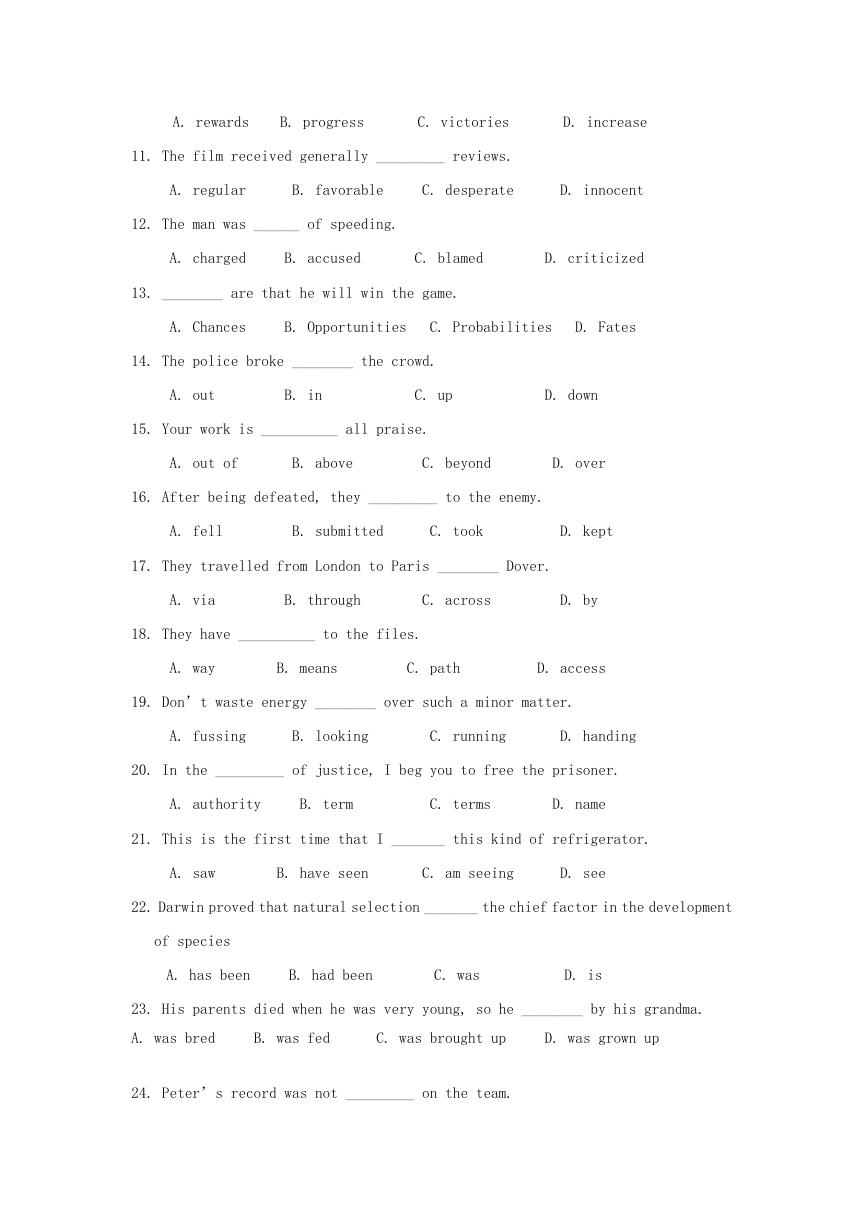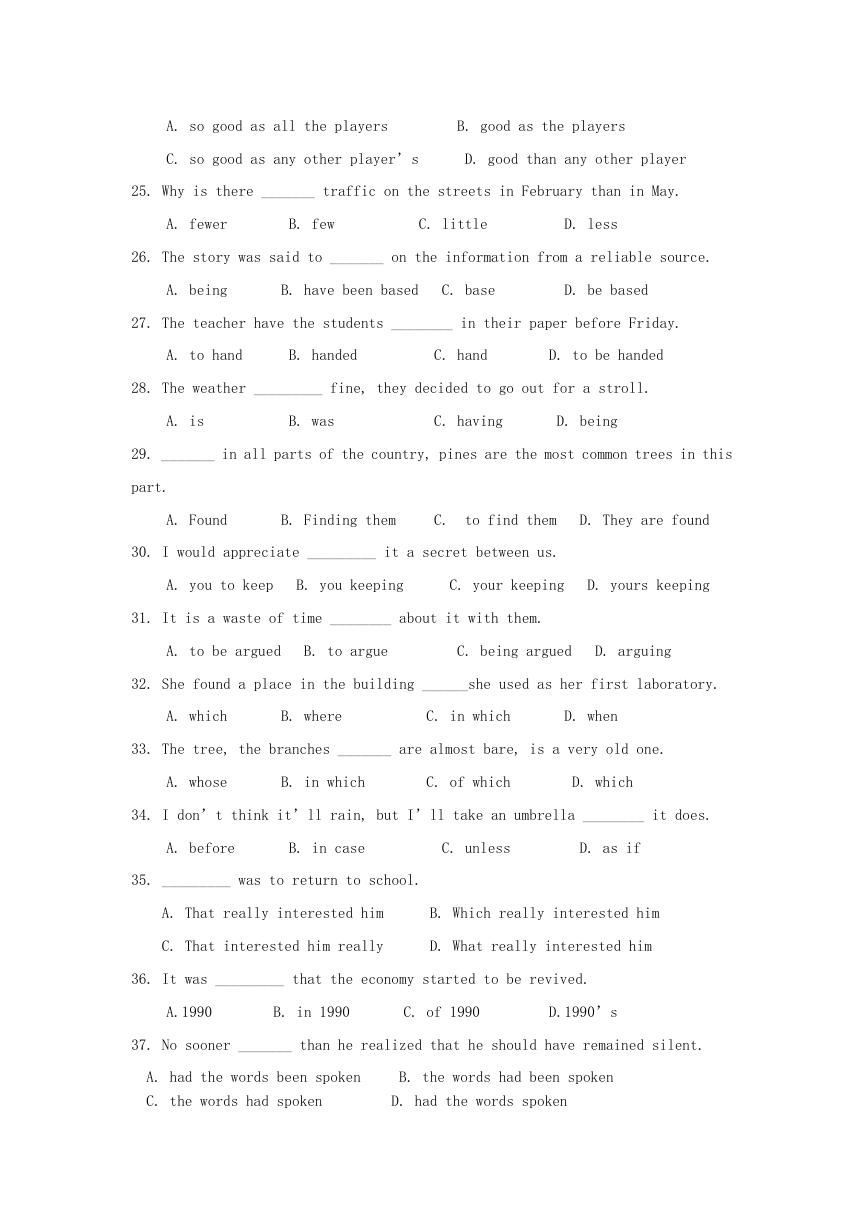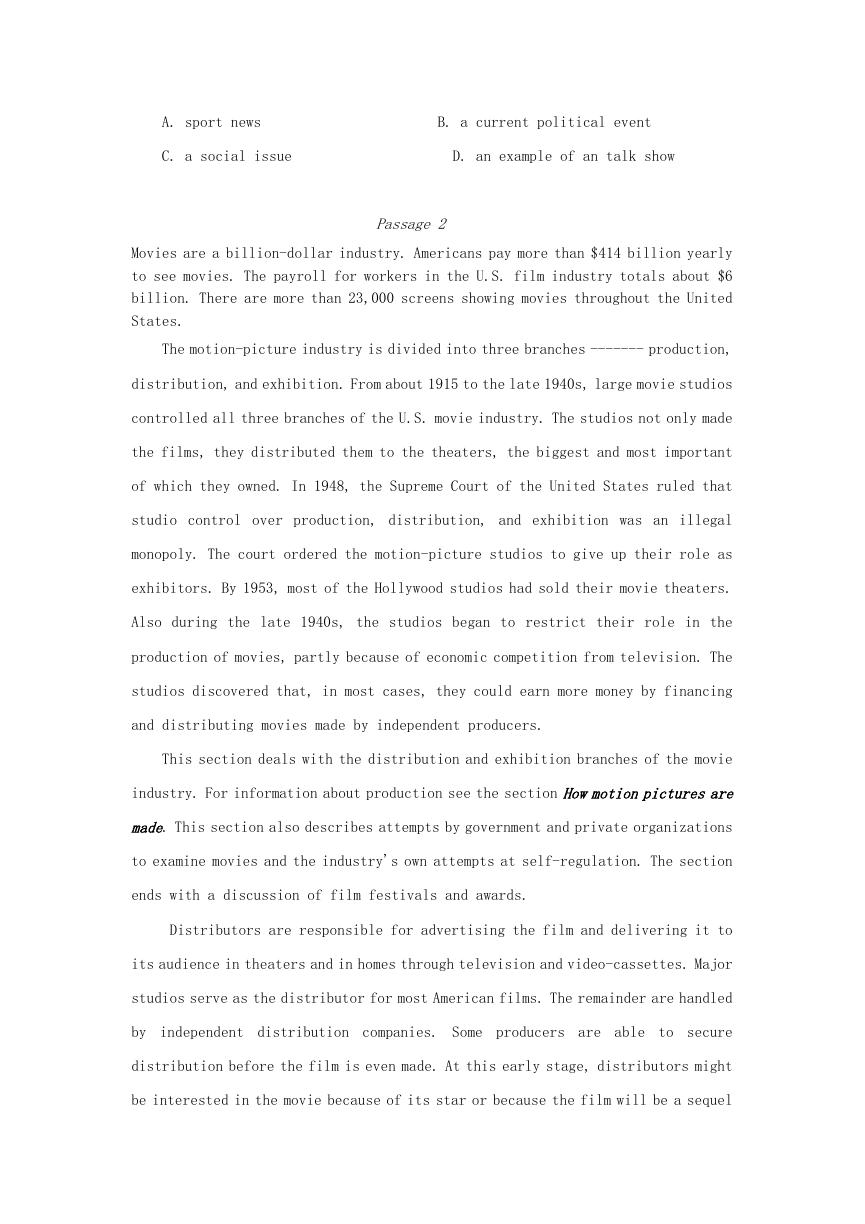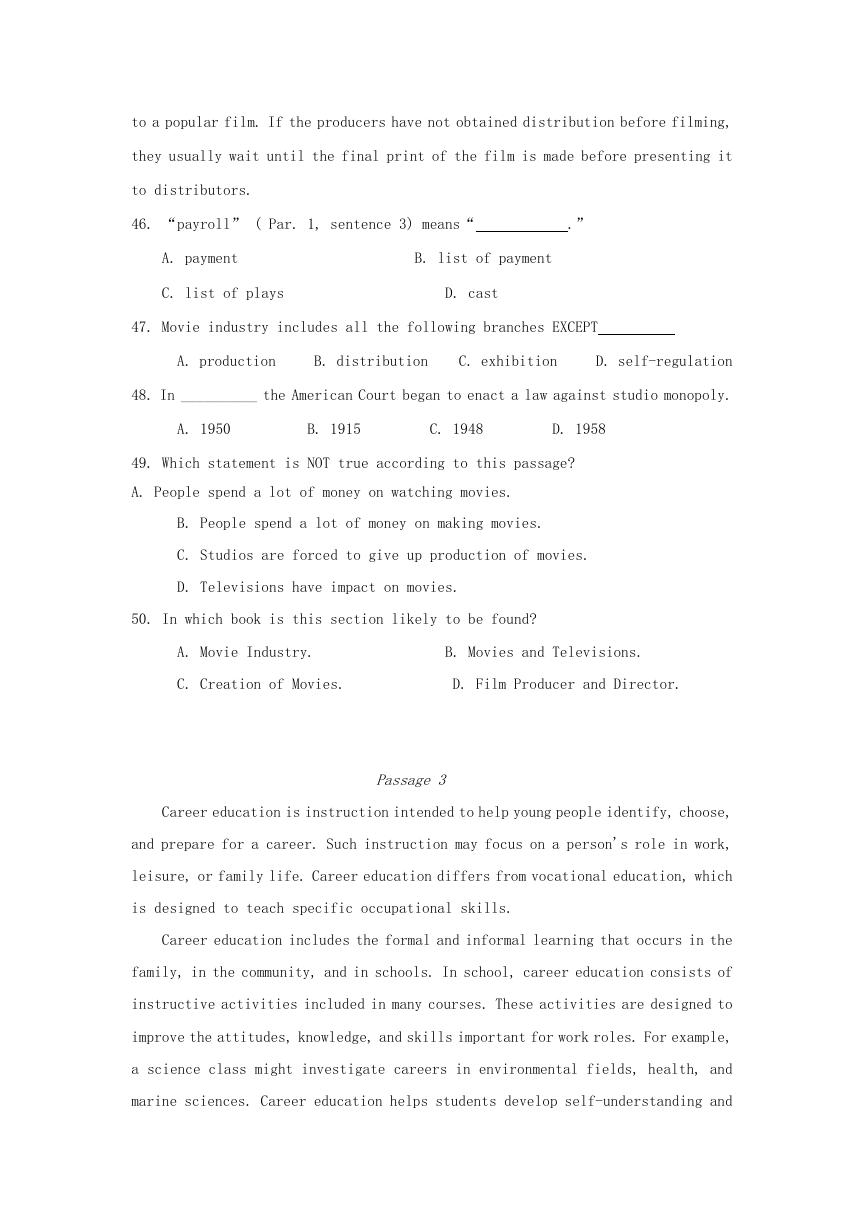2009 年云南昆明理工大学英语考研真题 A 卷
Part I
Vocabulary and structure
(20%)
Directions: In this section, there are 40 sentences. For each sentence there are
four choices marked A), B), C) and D). Choose one of the words which is
closestinmeaningtotheunderlinedwordortocompletethesentenceand
markyouranswerontheanswersheetwithasinglelinethroughthecenter.
1. He was wearing a decent suit in the party last night.
A. suitable
B. tight
C. loose
D. tidy
2. Several car manufactures will boot half of their workers because of the economic
difficulties.
A. discount
B. dispose
C. dismiss
D. disclose
3. A(n) frugal buyer purchases fruit and vegetables in season.
A. careful
B. clever
C. ignorant
D. economical
4. They had ample funds to cover the cost of the trip.
A. luxurious
B. sample
C. sufficient
D. superb
5. Eventually, the case proved to have nothing to do with him.
A. Remarkably
B. Naturally
C. Noticeably
D. Ultimately
6. All the living things have certain attributes that are passed on from one
generation to the next.
A. cells
B. viruses
C. traits
D. flaws
7. Traffic was moving at a crawl.
A. at a low pace
B. at an instant moment
C. within a certain distance
D. with a rapid speed
8. The story rings true.
A. tells
B. speaks
C. sounds
D. recounts
9. There have been a modest decrease in house prices this year.
A. little
B. humble
C. simple
D. quiet
10. The country made social and political gains under the new government.
�
A. rewards
B. progress
C. victories
D. increase
11. The film received generally _________ reviews.
A. regular
B. favorable
C. desperate
D. innocent
12. The man was ______ of speeding.
A. charged
B. accused
C. blamed
D. criticized
13. ________ are that he will win the game.
A. Chances
B. Opportunities
C. Probabilities
D. Fates
14. The police broke ________ the crowd.
A. out
B. in
C. up
D. down
15. Your work is __________ all praise.
A. out of
B. above
C. beyond
D. over
16. After being defeated, they _________ to the enemy.
A. fell
B. submitted
C. took
D. kept
17. They travelled from London to Paris ________ Dover.
A. via
B. through
C. across
D. by
18. They have __________ to the files.
A. way
B. means
C. path
D. access
19. Don’t waste energy ________ over such a minor matter.
A. fussing
B. looking
C. running
D. handing
20. In the _________ of justice, I beg you to free the prisoner.
A. authority
B. term
C. terms
D. name
21. This is the first time that I _______ this kind of refrigerator.
A. saw
B. have seen
C. am seeing
D. see
22. Darwin proved that natural selection _______ the chief factor in the development
of species
A. has been
B. had been
C. was
D. is
23. His parents died when he was very young, so he ________ by his grandma.
A. was bred
B. was fed
C. was brought up
D. was grown up
24. Peter’s record was not _________ on the team.
�
A. so good as all the players
B. good as the players
C. so good as any other player’s
D. good than any other player
25. Why is there _______ traffic on the streets in February than in May.
A. fewer
B. few
C. little
D. less
26. The story was said to _______ on the information from a reliable source.
A. being
B. have been based
C. base
D. be based
27. The teacher have the students ________ in their paper before Friday.
A. to hand
B. handed
C. hand
D. to be handed
28. The weather _________ fine, they decided to go out for a stroll.
A. is
B. was
C. having
D. being
29. _______ in all parts of the country, pines are the most common trees in this
part.
A. Found
B. Finding them
C.
to find them
D. They are found
30. I would appreciate _________ it a secret between us.
A. you to keep
B. you keeping
C. your keeping
D. yours keeping
31. It is a waste of time ________ about it with them.
A. to be argued
B. to argue
C. being argued
D. arguing
32. She found a place in the building ______she used as her first laboratory.
A. which
B. where
C. in which
D. when
33. The tree, the branches _______ are almost bare, is a very old one.
A. whose
B. in which
C. of which
D. which
34. I don’t think it’ll rain, but I’ll take an umbrella ________ it does.
A. before
B. in case
C. unless
D. as if
35. _________ was to return to school.
A. That really interested him
B. Which really interested him
C. That interested him really
D. What really interested him
36. It was _________ that the economy started to be revived.
A.1990
B. in 1990
C. of 1990
D.1990’s
37. No sooner _______ than he realized that he should have remained silent.
A. had the words been spoken
B. the words had been spoken
C. the words had spoken
D. had the words spoken
�
38. _________, he is still working in the factory.
A. As he is old
B. Is as he old
C. Old as he is
D. He is old as
39. I would have invited her to the party, but _______ her well.
A. don’t know
B. had not known
C. did not know
D. won’t know
40. It was imperative that he __________ hard.
A. worked
B. had worked
C. was working
D. work
Part II
Reading Comprehension
(40 points,)
Directions: In this section there are 4 passages. Each passage is followed by 5
questions or unfinished sentences. For each of them there are 4 choices
marked A, B, C and D Choose the best answer and mark your choice on the
ANSWER SHEET with a single line through the center.
Passage 1
Radio programming varies from country to country . This section describes
programming in the United States.About 90 percent of all programs broadcast in
the United States are designed for entertainment.The other 10 percent provide some
kind of
information. Radio stations compete with one another for listeners.Most
stations program broadcasts to appeal to a specific audience.For example,stations
that play rock music try to attract teenage and young adult listeners.
Recorded music is the chief kind of radio entertainment . Most stations
specialize in one kind of music,such as rock,classical,country and western,
or “old-time favorites.” Some stations broadcast several kinds of music.
Radio stations that broadcast music have disc jockeys who introduce and comment
on the music.They play an important role.Each station tries to hire disc jockeys
whose announcing styles and personalities appeal to the station’s largest audience.
Programs that provide information include newscasts, talk shows, and play-by-play
�
descriptions of sports events.Newscasts come on the air at regular times every
half-hour or hour on most stations.In addition,radio stations present on-the-spot
news coverage of such special events. as political conventions,space flights,
Senate hearings,and speeches by the President.Radio stations also broadcast such
specialized news as weather forecasts , traffic reports, and stock market and
agricultural information.Other news features include public service announcements
about community events,activities of community groups,and government services.A
few stations broadcast only news to serve listeners who prefer news programs to
music.
Talk shows present discussions on a variety of topics and interviews with people
from many professions.Each show has a host or hostess who leads the discussion
or does the interviewing.The subject of a program may be a current political topic,
such as an election or a government policy, or it may deal with a social issue,
such as crime,pollution,poverty, racism,or sexism.Many talk shows allow listeners
to take part in the program. Listeners are invited to telephone the station to ask
questions or give their opinions about the topic.
41. This passage is mainly about
A. music
C. talk shows
B. railway stations
D. radio stations
42. According to the passage,“disc jockey” (Par.3, sentence 1) means“
.”
A. disc operator
B. record player
C. host of a music station
D. reporter
43. In talk shows listeners can also be involved into the program through
A. televisions
B. telephones
C. being brought to the radio station
D. internet
44. You may get all the following information from stations EXCEPT
A. space flights
B. sports news
C. weather forecasts
D. stock list
45. The following paragraph will be about
�
A. sport news
B. a current political event
C. a social issue
D. an example of an talk show
Passage 2
Movies are a billion-dollar industry. Americans pay more than $414 billion yearly
to see movies. The payroll for workers in the U.S. film industry totals about $6
billion. There are more than 23,000 screens showing movies throughout the United
States.
The motion-picture industry is divided into three branches ------- production,
distribution, and exhibition. From about 1915 to the late 1940s, large movie studios
controlled all three branches of the U.S. movie industry. The studios not only made
the films, they distributed them to the theaters, the biggest and most important
of which they owned. In 1948, the Supreme Court of the United States ruled that
studio control over production, distribution, and exhibition was an illegal
monopoly. The court ordered the motion-picture studios to give up their role as
exhibitors. By 1953, most of the Hollywood studios had sold their movie theaters.
Also during the late 1940s, the studios began to restrict their role in the
production of movies, partly because of economic competition from television. The
studios discovered that, in most cases, they could earn more money by financing
and distributing movies made by independent producers.
This section deals with the distribution and exhibition branches of the movie
industry. For information about production see the section Howmotionpicturesare
made. This section also describes attempts by government and private organizations
to examine movies and the industry's own attempts at self-regulation. The section
ends with a discussion of film festivals and awards.
Distributors are responsible for advertising the film and delivering it to
its audience in theaters and in homes through television and video-cassettes. Major
studios serve as the distributor for most American films. The remainder are handled
by independent distribution companies. Some producers are able to secure
distribution before the film is even made. At this early stage, distributors might
be interested in the movie because of its star or because the film will be a sequel
�
to a popular film. If the producers have not obtained distribution before filming,
they usually wait until the final print of the film is made before presenting it
to distributors.
46. “payroll” ( Par. 1, sentence 3) means“
.”
A. payment
B. list of payment
C. list of plays
D. cast
47. Movie industry includes all the following branches EXCEPT
A. production
B. distribution
C. exhibition
D. self-regulation
48. In __________ the American Court began to enact a law against studio monopoly.
A. 1950
B. 1915
C. 1948
D. 1958
49. Which statement is NOT true according to this passage?
A. People spend a lot of money on watching movies.
B. People spend a lot of money on making movies.
C. Studios are forced to give up production of movies.
D. Televisions have impact on movies.
50. In which book is this section likely to be found?
A. Movie Industry.
B. Movies and Televisions.
C. Creation of Movies.
D. Film Producer and Director.
Passage 3
Career education is instruction intended to help young people identify, choose,
and prepare for a career. Such instruction may focus on a person's role in work,
leisure, or family life. Career education differs from vocational education, which
is designed to teach specific occupational skills.
Career education includes the formal and informal learning that occurs in the
family, in the community, and in schools. In school, career education consists of
instructive activities included in many courses. These activities are designed to
improve the attitudes, knowledge, and skills important for work roles. For example,
a science class might investigate careers in environmental fields, health, and
marine sciences. Career education helps students develop self-understanding and
�
use it to plan their education and working life.
A complete career education program in school begins in kindergarten and
continues at least through high school. Many colleges and universities also offer
career education through their counseling programs. In kindergarten and elementary
school, youngsters learn about different types of work. In middle school or junior
high school, children begin to explore the occupations and leisure activities that
interest them most. School counselors and teachers help children find educational
and occupational opportunities that match their abilities and interests. In high
school, students get more specific information about occupations and life styles.
They may be in classroom, small group, or individual sessions where they learn how
to make career decisions. They also should obtain the skills they need for further
study or for a job after graduation. Counselors provide information on such matters
as how to locate and apply for jobs and how to be successful in interviews.
Teachers and counselors use a variety of methods to provide career education,
including films about occupations or industries. Children may invite parents or
other adults to come to school and describe their jobs. A student may accompany
a worker on the job. Cooperative education combines classroom study with practical
work experience.
51. According to the passage, which statement is true?
A. Career education is carried out in primary schools.
B. Career education is carried out in middle schools.
C. Career education is carried out in colleges.
D. Career education is carried out in the whole process of children's education.
52. It may be inferred from the passage that
A. not only teachers but also parents are responsible for the career education
B. in high school, students know more specific information about occupations
C. career education may be in classroom, small group, or individual sessions
D. teachers use a variety of methods to provide career education, including
films
53. A child may get career education in all the following places EXCEPT
A. school
B. family
C. community
D. public places
54. “Kindergarten” ( Para.3, sentence 3) is a place for
years old
�
















 2023年江西萍乡中考道德与法治真题及答案.doc
2023年江西萍乡中考道德与法治真题及答案.doc 2012年重庆南川中考生物真题及答案.doc
2012年重庆南川中考生物真题及答案.doc 2013年江西师范大学地理学综合及文艺理论基础考研真题.doc
2013年江西师范大学地理学综合及文艺理论基础考研真题.doc 2020年四川甘孜小升初语文真题及答案I卷.doc
2020年四川甘孜小升初语文真题及答案I卷.doc 2020年注册岩土工程师专业基础考试真题及答案.doc
2020年注册岩土工程师专业基础考试真题及答案.doc 2023-2024学年福建省厦门市九年级上学期数学月考试题及答案.doc
2023-2024学年福建省厦门市九年级上学期数学月考试题及答案.doc 2021-2022学年辽宁省沈阳市大东区九年级上学期语文期末试题及答案.doc
2021-2022学年辽宁省沈阳市大东区九年级上学期语文期末试题及答案.doc 2022-2023学年北京东城区初三第一学期物理期末试卷及答案.doc
2022-2023学年北京东城区初三第一学期物理期末试卷及答案.doc 2018上半年江西教师资格初中地理学科知识与教学能力真题及答案.doc
2018上半年江西教师资格初中地理学科知识与教学能力真题及答案.doc 2012年河北国家公务员申论考试真题及答案-省级.doc
2012年河北国家公务员申论考试真题及答案-省级.doc 2020-2021学年江苏省扬州市江都区邵樊片九年级上学期数学第一次质量检测试题及答案.doc
2020-2021学年江苏省扬州市江都区邵樊片九年级上学期数学第一次质量检测试题及答案.doc 2022下半年黑龙江教师资格证中学综合素质真题及答案.doc
2022下半年黑龙江教师资格证中学综合素质真题及答案.doc